Sudan
Things to DO
Bayuda Desert
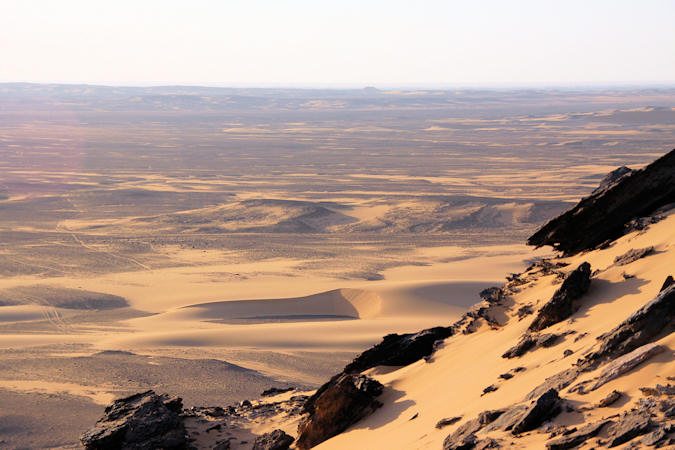 |
|||||
The area bounded by the loop formed by the Nile between the 4th and the 6th Cataract is called the Bayuda Desert,
and characterized by sharp black basalt mountains, most of them volcanic and typically cone-shaped.
They alternate with level pebble stretches and large valleys crossed by dry wadis, where little vegetation can be seen.
It is very likely to meet isolated groups of Bisharin nomad's, who live in familiar groups in small huts made of intertwined
branches close to the rare water wells, with their caravans and herds of camels and cattle.
Just in the centre of the Bayuda Desert we reach Atrun Crater, where nomads gather salt from the edge of a green colored
pool.
They collect the salt and load it on camels or donkeys, then move in small caravans to sell it into the markets of the
villages along the Nile. An incredible work that remained the same across the centuries
Meroë
While there was a settlement at Meroë as early as 890 BC, the culture flourished at its height between 300 BC and 350 AD.
The Kingdom of Kush was ruled by Nubians who, early on, continued Egyptian practices and customs and, though they were depicted
in art as distinctly Nubian, called themselves by Egyptian titles.
In time, however, these practices gave way to indigenous customs and the Egyptian heiroglyphs were replaced by a new system of
writing known as Meroitic.
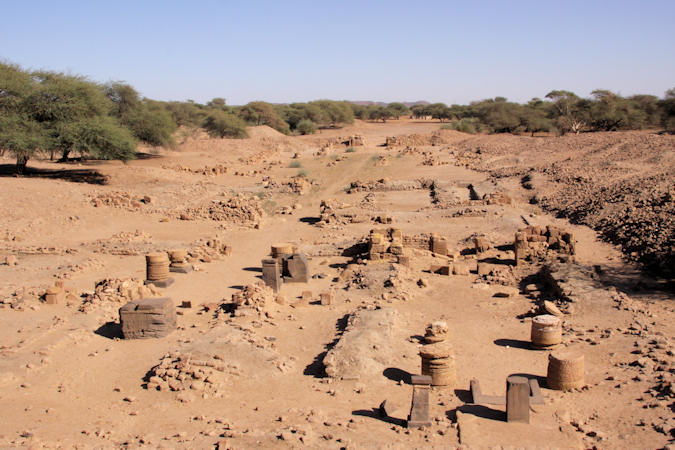 |
|||||
The break from Egyptian culture is explained by the ancient historian Diodorus Siculus who writes that in the time before
the reign of King Arkamani I (295-275 BCE), it had been the custom for the high priests of the Egyptian god Amun at
Jebel Barkal to decide who became king and to set the duration of the king’s reign.
As the health of the king was tied to the fertility of the land, the priests had the power to determine if the sitting king was
no longer fit to rule.
If they deemed him unfit, they would send a message to the king, understood to be from the god Amun himself, advising him that the
time of his rule on earth was completed and that he must die.
The kings had always obeyed the divine orders and had taken their own lives for the supposed good of the people.
Arkamani was the first to disdain this command. With the determination worthy of a king he came with an armed force to the forbidden
place and slaughtered all the priests, abolished this tradition, and instituted practices at his own discretion.
Arkamani I was the first king to institute burial outside of Meroe (instead of following the practice of burying the dead at
Nuri according to Egyptian custom) and passed the laws which would make Meroe a culture distinct from that of Egypt.
Egyptian language, writing, and art disappear from the archaelogical evidence after this
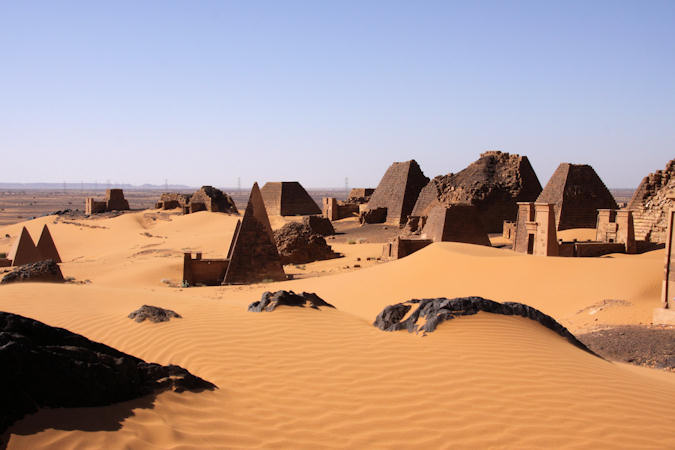 |
|||||
time (roughly 285 BCE).
The ancient Egyptian gods Isis and Amon-Ra were melded into the worship of Nubian deities like Apedemak
the lion god, and queens, rather than male pharaohs, shared the political power in the land with the king.
The most visible remains at Meroe are its Pyramids, which contained the tombs of more than forty kings, queens, and other
important individuals.
While these royal tombs were all plundered in ancient times, frescos preserved in the tombs show that the rulers were either burned,
mummified (or not), and then covered with jewelry and laid in wooden cases.
Additional damage was done to the pyramids by the 19th century Italian explorer Giuseppe Ferlini who demolished the tops of
more than forty pyramids in his search for treasures. Ferlini found gold in only one pyramid and his plundered artifacts were
later sold to European museums.
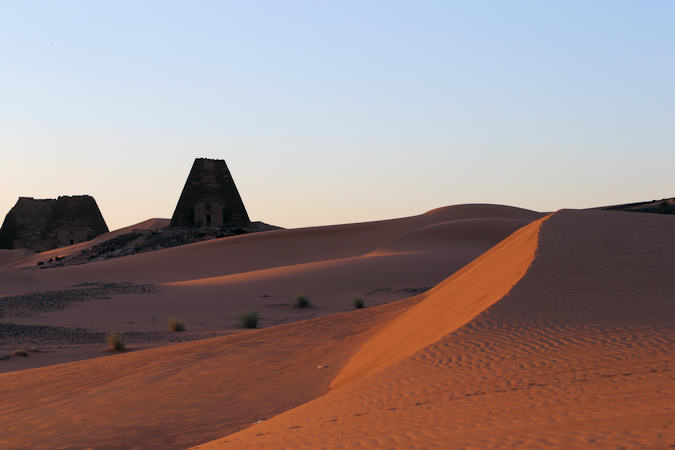 |
|||||
Today Meroë is the largest archaeological site in the Sudan.
Situated about a half a mile from the Nile, the city ruins extend over a square mile in area. The site of the Royal city is now
overgrown with low acacia trees and scrub, making it hard for visitors to envisage its original extent.
The Pyramids are Sudan's most popular tourist attraction, although in a country where tourism is in its infancy, popular is a
relative term - you are still likely to have the site for yourself.
At Maroë the charm of the unknown is the great attraction - visitors can enjoy the rare sensation that they are discovering a
long-hidden secret, without a tout offering a cammel ride or belly dance in sight
Instead , it's just you and the pyramids alone in the desert.
Musawwarat es-Sufra
The Great Enclosure of Musawwarat es Sufra, one of the major ancient monuments of northern Sudan and inscribed on the World Heritage List in 2011, is a well known but enigmatic complex of temples and other buildings, corridors, ramps and courtyards.
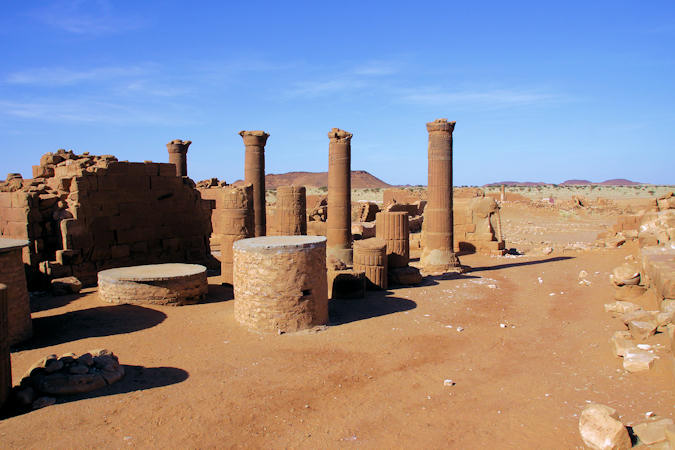 |
|||||
The parts of the labyrinth-like building complex, which covers
c. 45.000 square metres, were erected in the third century BC, i.e. at the beginning of the so-called Meroitic period
(c. 300 BC-AD 350) of the Kushite realm.
The function(s) of various parts of the building complex as well as the purpose of this unique site are still contested.
The most favoured explanation for the existence of Musawwarat es Sufra is as a cult centre and pilgrimage site, possibly for
Apedemak
The open parts of the Great Enclosure may have been used to house pilgrims, or animals used in religious ceremonis.
The frequency of carvings of Elephants throughout the complex suggests that elephants may have been used or possibly trained
here, a vieuw given credence by the number of low ramps inside the Great Enclosure that would have allowed acces for the animals.
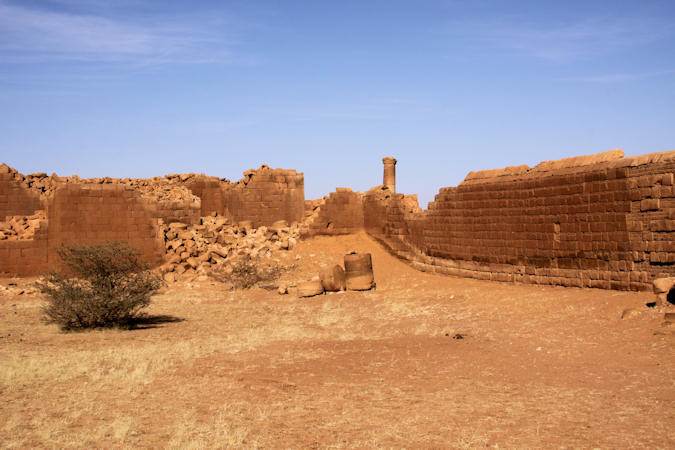 |
|||||
The great Enclosure is liberally coverd with carvings and ancient graffiti. Many of these stem from the Meroitc period
but also from the younger post-Meroitic, Christian and Islamic periods.
The graffiti, which name and depict gods, humans, animals - sometimes arranged in scenes, and which show symbols, objects and others,
may hold a key to the interpretation of the diachronic use of this site.
The complex is still an active archeological site, and during winter season you can find German archaeologists directing the work.
During their work it appeared that many valuable architectural pieces were exposed to the elements but should be sheltered for further
protection.
In 2000 the Germans therefore started to build a Open-air Museum, which was opened for public in march 2004
The Lion Temple
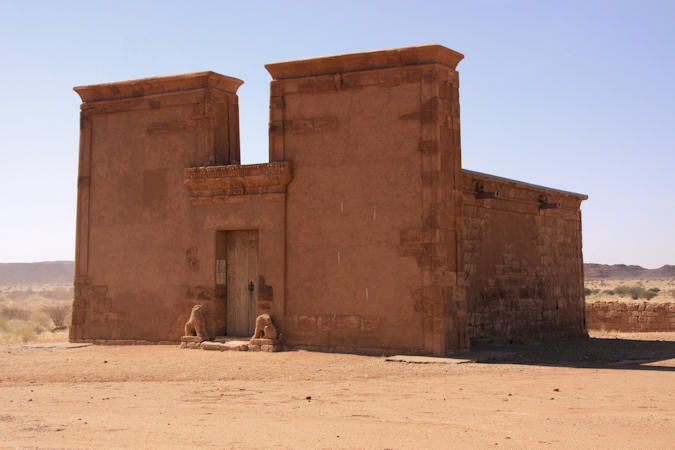 |
|||||
The Lion Temple of Musawwarat es-Sufra dates to the late 3d century BC, to the reign of the Meroitic king
Arnakhamani (235-218 BC).
The temple with its pylon and six interior columns is the first known Meroitic one-room temple. This type of temple was
specifically built for the cult of indigenous gods and differs in its structure from temples built for gods from the Egyptian
pantheon.
The temple was dedicated to the powerful local Meroitic lion-headed god Apedemak, who may have been worshipped at Musawwarat
already before the construction of the sandstone building.
The inner and outer walls of the Lion Temple as well as its columns were decorated with reliefs. On the outer north and south wall
the king and a prince are shown offering to Apedemak and other male and female gods.
This distinction in groupings of male and female gods possibly reflects concepts of war/destruction and peace/creation.
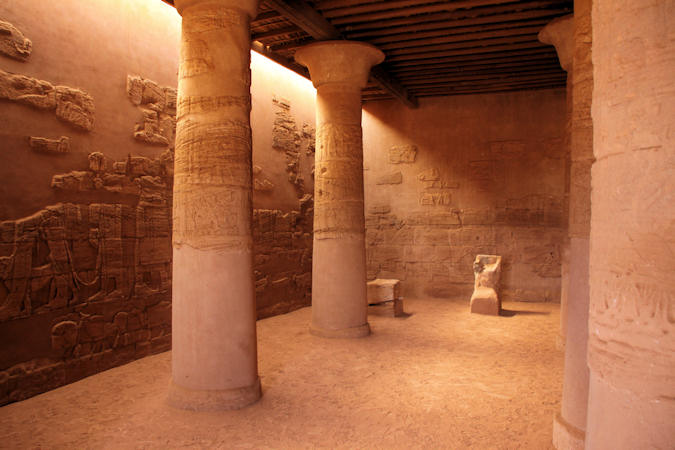 |
|||||
The six columns in the interior of the temple are decorated with vignettes showing the king before gods as well as various
scenes with mythical beings, such as sphinxes.
The interior wall reliefs show the king before the gods Apedemak and Amun as well as various greeting, offering and coronation
scenes.
The Lion Temple was surrounded by an oval enclosure.
The temple collapsed in antiquity in a manner that preserved its walls well enough to allow its re-erection by its excavator,
Fritz Hintze, in 1969/70.
Naqa
The exact purpose of the site at Naqa is still unclear. As well as the Lion and Amun temples there is a cemetery south of
the site that has yet to be excavated.
Surveys have shown little evidenmce of permanent settlement at Naqa. Far from the Nile as it is, the area is very dry and nearby
wadi could only have supported seasonal rain-fed agriculture at best.
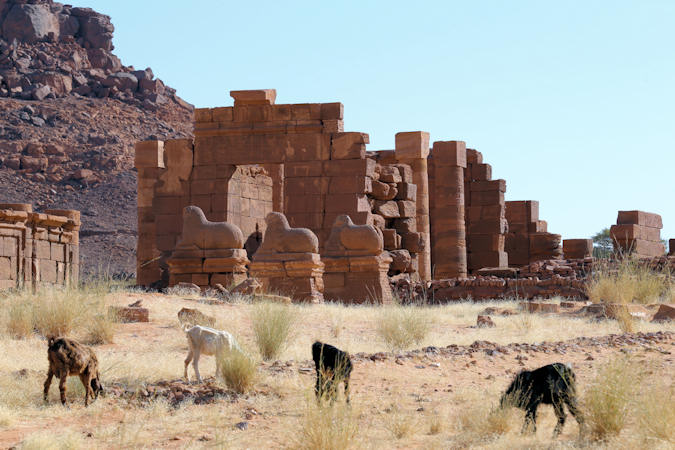 |
|||||
On approching the site, the first temple you will see is the Temple of Amun, on the western site near the food of a rocky
outcrop.
The temple was erected in the 1st century AD by king
It follows a traditional Egyptian floor plan of an outer court with a colonnade approaching a hypostyle hall containing an inner
sanctuary chamber, and would originally have been around 100m long.
The temple is approached through a short avenue of rams in a similar manner to the Temple of Amun at Jebel Barkal and
Kernak (egypt).
German archaeologists are currently excavating in the temple, which has been partially reconstructed.
The main entrances and walls show delicate relief carvings and many columns have been re-erected.
The temple is aligned on an east-west axis and the eastern sides have exposed to the abrasive effects of sand and wind. The rams have
similary suffered from the elements.
Lion Temple & Kiosk
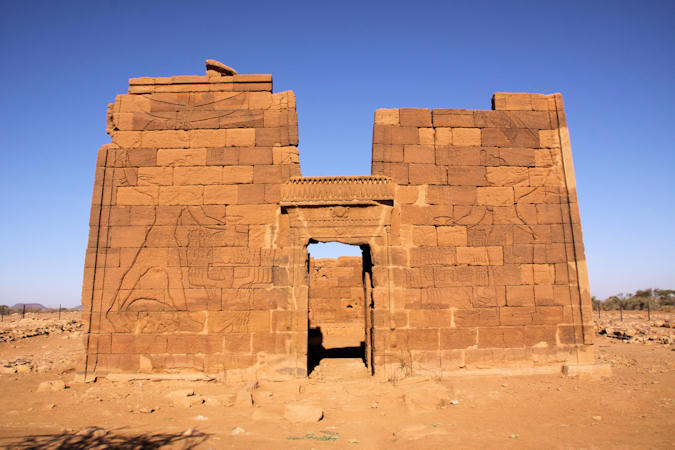 |
|||||
The temple is dated to the reign of King Natakamani and Queen Amanitore in the 1st century CE.
In this temple there are on the southern side (left of the temple axis) only male and on the northern (right of the temple axis)
only female deities.
The two temple halves are associated with different deities, the left half with Apedemak and the right with Amun.
The iconographic equilibrium shifts there from the dualism of Apedemak–Amun to the dualism of king–queen.
This reflects the co-rule of Natakamani and Amanitore, a new development or perhaps a unique case in Kushite history.
The equal status of the king and queen is clear on the reliefs, nowhere more so than on the exterior of the pylon. Here the rulers
are shown at the same scale and performing identical tasks, smiting the enemies of Kush.
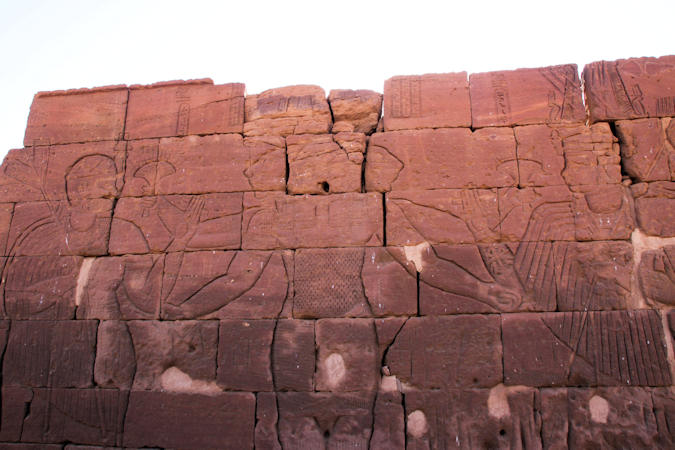 |
|||||
On the rear wall of the temple is the most famous depiction of Apedemak.
He stands to receave offerings from Natakamani and Amanitore on either side. To allow him to do this he appears double-armed and
triple-headed, facing both supplicants as well as the vieuwer.
The edges of the pylon carry beatiful representations of Apedemak, represented with the body of a snake, emerging from a lotus
flower.
In front of the Lion Temple is a small Kiosk, usually referred to as the Roman kiosk, due to its Classical style.
It is a showcase for the different influences on Kushite architecture, although the date of construction is disputed.
Its entrance is Egyptian, topped by a flat lintel with a row of sacred cobras (ureaus), but the open sides are a riot of collumns
topped with florid Corinthian capitals and Roman-style arched windows.